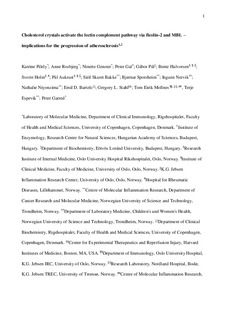Cholesterol crystals activate the lectin complement pathway via ficolin-2 and mannose-binding lectin: Implications for the progression of atherosclerosis
Pilely, Katrine; Rosbjerg, Anne; Genster, Ninette; Gál, Peter; Pál, Gábor; Halvorsen, Bente; Holm, Sverre; Aukrust, Pål; Bakke, Siril Skaret; Sporsheim, Bjørnar; Nervik, Ingunn; Niyonzima, Nathalie; Bartels, Emil D.; Stahl, Gregory L.; Mollnes, Tom Eirik; Espevik, Terje; Garred, Peter
Journal article
Submitted version
Permanent lenke
http://hdl.handle.net/11250/2488606Utgivelsesdato
2016Metadata
Vis full innførselSamlinger
Sammendrag
Cholesterol crystals (CC) play an essential role in the formation of atherosclerotic plaques. CC activate the classical and the alternative complement pathways, but the role of the lectin pathway is unknown. We hypothesized that the pattern recognition molecules (PRMs) from the lectin pathway bind CC and function as an upstream innate inflammatory signal in the pathophysiology of atherosclerosis. We investigated the binding of the PRMs mannose-binding lectin (MBL), ficolin-1, ficolin-2, and ficolin-3, the associated serine proteases, and complement activation products to CC in vitro using recombinant proteins, specific inhibitors, as well as deficient and normal sera. Additionally, we examined the deposition of ficolin-2 and MBL in human carotid plaques by immunohistochemistry and fluorescence microscopy. The results showed that the lectin pathway was activated on CC by binding of ficolin-2 and MBL in vitro, resulting in activation and deposition of complement activation products. MBL bound to CC in a calcium-dependent manner whereas ficolin-2 binding was calcium-independent. No binding was observed for ficolin-1 or ficolin-3. MBL and ficolin-2 were present in human carotid plaques, and binding of MBL to CC was confirmed in vivo by immunohistochemistry, showing localization of MBL around CC clefts. Moreover, we demonstrated that IgM, but not IgG, bound to CC in vitro and that C1q binding was facilitated by IgM. In conclusion, our study demonstrates that PRMs from the lectin pathway recognize CC and provides evidence for an important role for this pathway in the inflammatory response induced by CC in the pathophysiology of atherosclerosis.
